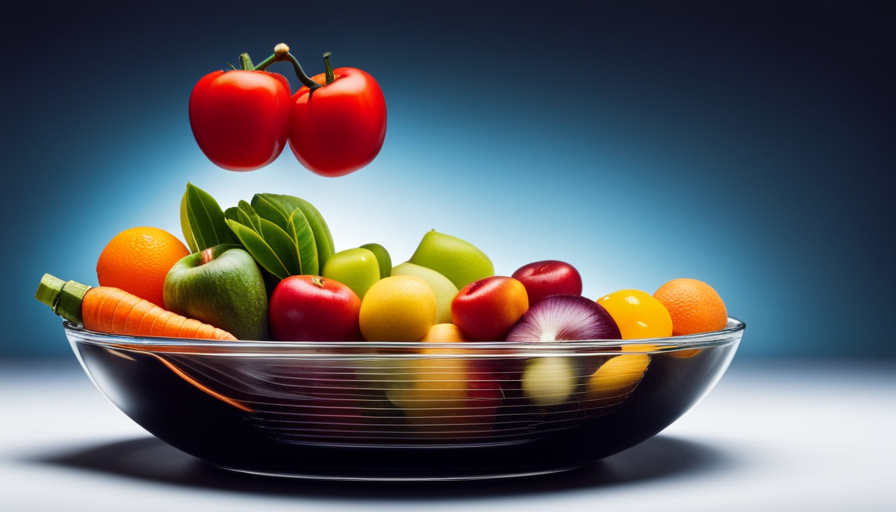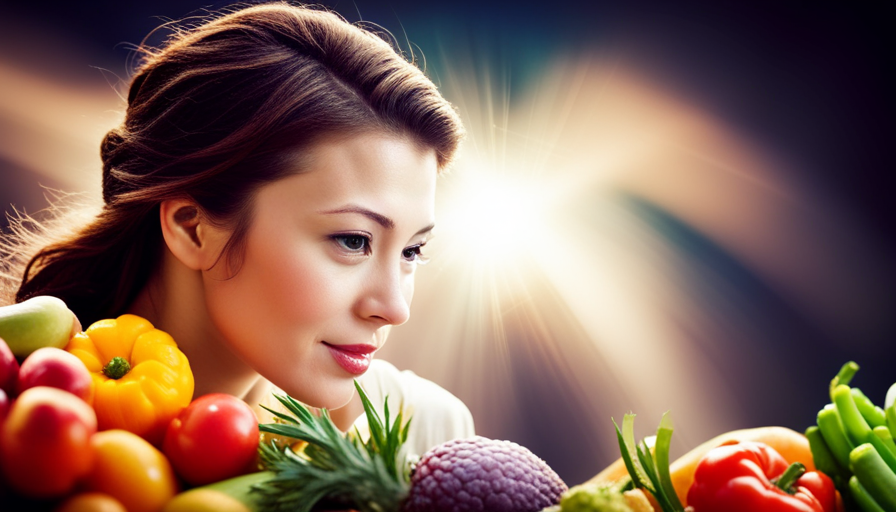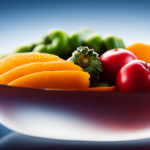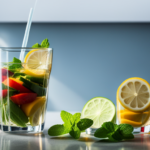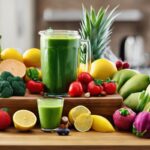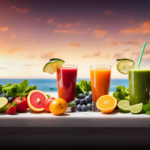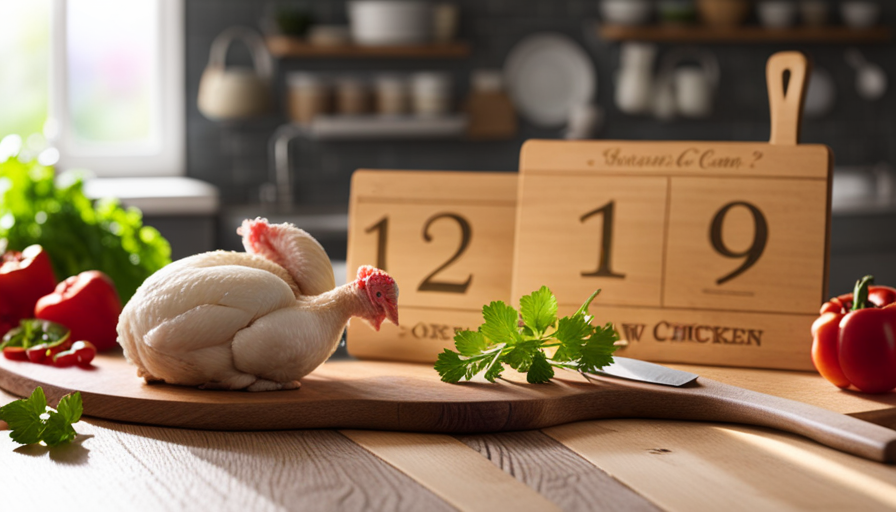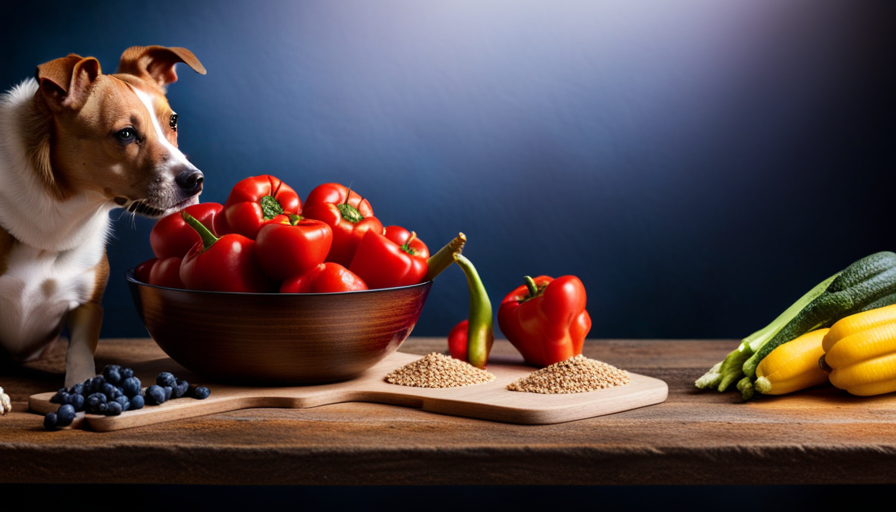Imagine yourself savoring a fresh, juicy apple under the sunny summer sky. Just like how the apple satisfies your thirst and revitalizes your body, **water** is equally essential in keeping you hydrated when embracing a raw food lifestyle. Stay refreshed and nourished from within with plenty of water intake! Start experiencing the benefits today.
As an avid advocate for this lifestyle, I have discovered the importance of staying properly hydrated for optimal digestion and overall well-being.
In this article, we will explore the benefits of staying hydrated on a raw food diet, discuss the role of water in digestion, and provide practical tips for incorporating hydration into your daily routine.
From drinking water before meals to staying hydrated during workouts, we will delve into the various ways to ensure you are getting enough water throughout your day.
So grab a glass of water and let’s dive into the world of raw food and hydration!
Key Takeaways
- Staying hydrated on a raw food diet is important for digestion and overall well-being.
- Raw fruits and vegetables naturally contain water and electrolytes for hydration.
- Drinking water before meals improves digestion and increases satiety.
- Staying hydrated throughout the day is crucial for overall well-being and bodily functions.
Benefits of Staying Hydrated on a Raw Food Diet
Staying hydrated on a raw food diet has incredible benefits that’ll make you feel refreshed and energized throughout the day! Drinking water is essential for overall health and well-being, and it becomes even more important when following a raw food diet. Proper hydration has numerous benefits, such as maintaining optimal bodily functions, regulating body temperature, and promoting healthy skin.
One of the key benefits of drinking water on a raw food diet is its role in digestion. Water helps break down the food we consume, aiding in the absorption of nutrients and the elimination of waste. It also helps prevent constipation, which can be a common issue for those transitioning to a raw food diet.
In addition to digestion, staying hydrated is crucial for maintaining energy levels. Water is a primary component of our blood, which carries oxygen and nutrients to our cells. When we’re dehydrated, our blood thickens, making it harder for our heart to pump and deliver these essential substances. By drinking enough water, we can ensure that our body functions optimally and keeps us feeling energized throughout the day.
The benefits of drinking water on a raw food diet are numerous. From aiding digestion to maintaining energy levels, staying hydrated is of utmost importance. So, let’s dive into the next section and explore the importance of water for digestion.
Importance of Water for Digestion
Ensuring proper hydration is essential for optimal digestion. Are you aware of how water aids in the digestion process? Let me break it down for you:
-
Water helps break down food: When you eat raw food, it contains enzymes that aid in digestion. However, these enzymes work best in a watery environment. Drinking water before and during meals helps to create this environment, allowing the enzymes to efficiently break down the food.
-
Water promotes nutrient absorption: Hydration plays a crucial role in the absorption of nutrients from the food you eat. It helps to transport these nutrients from the digestive system into the bloodstream, where they can be utilized by the body. Without enough water, nutrient absorption can be compromised.
-
Water prevents constipation: Raw food is rich in fiber, which aids in healthy digestion. However, without sufficient water, fiber can actually have the opposite effect and lead to constipation. Drinking an adequate amount of water helps to soften the stool, making it easier to pass.
Proper hydration is not only important for digestion but also for overall health and well-being. Now that you understand the importance of water in digestion, let’s move on to some hydration tips for raw food enthusiasts.
Hydration Tips for Raw Food Enthusiasts
Quench your thirst and keep your body hydrated with these helpful tips for raw food enthusiasts. Staying hydrated is essential for overall health and is especially important when following a raw food diet.
Raw fruits and vegetables naturally contain water, which can contribute to your daily hydration needs. Additionally, consuming raw foods can provide numerous benefits for hydration. Raw foods are rich in electrolytes, such as potassium and magnesium, which are crucial for maintaining proper hydration levels in the body. These electrolytes help regulate fluid balance and ensure that your cells are adequately hydrated.
To stay hydrated on a raw food diet, it’s important to consume a variety of hydrating fruits and vegetables, such as watermelon, cucumber, and celery. These foods have high water content and can help replenish your body’s fluid levels. Drinking fresh juices and smoothies made from raw fruits and vegetables is another great way to stay hydrated. These beverages not only provide essential nutrients but also contribute to your daily water intake.
In addition to consuming hydrating foods, it’s important to drink water throughout the day. Aim to drink at least 8 glasses of water daily to maintain optimal hydration levels. It’s also helpful to carry a water bottle with you at all times, so you can easily sip water throughout the day. Remember, staying hydrated is key for proper digestion and overall well-being.
Transition: Now that we know the importance of staying hydrated on a raw food diet, let’s explore another aspect of optimal digestion – drinking water before meals.
Drink Water Before Meals for Optimal Digestion
Boost your digestion by hydrating yourself before meals, allowing your body to absorb nutrients more efficiently and experience increased satiety. When you drink water before a meal, it can have several benefits for your overall health.
Here are four reasons why drinking water before meals is beneficial:
-
Improved digestion: Water helps to soften food, making it easier to break down and digest. This can prevent issues like bloating and indigestion, allowing your body to efficiently process the nutrients from your meal.
-
Increased satiety: Drinking water before a meal can help you feel fuller, leading to reduced calorie intake and potential weight loss. It gives your stomach a sense of fullness, curbing your appetite and preventing overeating.
-
Enhanced nutrient absorption: Adequate hydration ensures that your body can effectively absorb the essential nutrients from your food. This can lead to better overall health and improved energy levels.
-
Aid in weight loss: Research suggests that drinking water before a meal can help with weight loss. It may increase metabolism and temporarily boost calorie burning.
By drinking water before meals, you can optimize your digestion and promote better health. But it’s not just about pre-meal hydration; staying hydrated throughout the day is equally important for overall well-being and optimal bodily functions.
Stay Hydrated Throughout the Day
To maintain optimal bodily functions and promote overall well-being, it’s crucial to keep yourself adequately hydrated throughout the day. Staying hydrated plays a significant role in various aspects of our health, including raw food and skin health, as well as energy levels.
When it comes to raw food and skin health, hydration is key. Raw fruits and vegetables are packed with vitamins and minerals that nourish our skin, but they also contain high water content. Consuming these raw foods helps hydrate our bodies from within, contributing to a healthy, glowing complexion.
Furthermore, staying hydrated is essential for maintaining energy levels. Dehydration can lead to fatigue and decreased cognitive function, making it harder to stay focused and alert throughout the day. By drinking enough water, we can ensure our bodies have the necessary hydration to keep us energized and performing at our best.
To help you visualize the importance of staying hydrated, here’s a table showcasing the benefits of proper hydration:
| Benefits of Hydration |
|---|
| Improved skin health |
| Increased energy levels |
| Enhanced cognitive function |
| Efficient digestion |
| Regulation of body temperature |
Considering the numerous benefits of staying hydrated, it’s important to make a conscious effort to drink enough water throughout the day. By doing so, you can support your overall well-being and promote optimal bodily functions. So, when it comes to raw snacks, consider incorporating water into your routine for maximum hydration.
Consider Drinking Water with Raw Snacks
Make sure you have a refreshing glass of water by your side when enjoying your favorite raw snacks – it’s like having a cool oasis in the desert to keep you hydrated and satisfied.
Drinking water with raw snacks has numerous benefits for your hydration and overall health. Raw foods, such as fruits and vegetables, are naturally high in water content, which can contribute to your daily fluid intake. However, pairing them with water can enhance their hydrating effects even more.
When you consume raw snacks, your body uses water to aid in digestion, absorption, and transportation of nutrients. By drinking water alongside these snacks, you can support these processes and optimize the benefits of the raw food you’re eating. Additionally, staying hydrated throughout the day can help regulate body temperature, support joint health, and promote healthy skin.
Incorporating water into your raw food diet is essential for maintaining proper hydration levels. While the amount of water you need may vary depending on factors such as activity level and climate, a general guideline is to drink at least eight 8-ounce glasses of water per day. However, it’s important to listen to your body’s cues and drink more if you feel thirsty or if you’re engaging in strenuous activities that cause you to sweat.
Transitioning into the subsequent section about ‘how much water should you drink on a raw food diet?’ without writing ‘step,’ it’s crucial to understand the importance of hydration in optimizing the benefits of a raw food lifestyle.
How Much Water Should You Drink on a Raw Food Diet?
Ensuring proper hydration is crucial when following a raw food lifestyle; therefore, it’s essential to understand the optimal amount of water to consume. When it comes to water intake guidelines, there isn’t a one-size-fits-all approach. The amount of water you need depends on various factors such as your age, weight, activity level, and climate.
However, a general recommendation is to drink at least eight 8-ounce glasses of water per day, which equals about 2 liters or half a gallon. This may need to be adjusted based on individual needs.
In a raw food diet, it’s important to stay hydrated as many raw fruits and vegetables contain high water content, aiding in hydration. However, relying solely on these sources may not be enough to meet your daily water requirements. Apart from plain water, other best sources of hydration include herbal teas, coconut water, and fresh fruit and vegetable juices. These options not only provide hydration but also offer additional nutrients.
Transitioning into the subsequent section about staying hydrated during workouts and physical activity, it’s important to prioritize water intake during these times as well. Regular exercise increases fluid loss through sweat, so it’s essential to replenish these fluids to avoid dehydration.
Stay Hydrated During Workouts and Physical Activity
Staying hydrated during workouts and physical activity is crucial to avoid dehydration and replenish fluids lost through sweat. When following a raw food diet, it’s important to pay attention to your hydration levels, as raw foods typically have a higher water content than cooked foods. Incorporating raw food hydration tips into your workout routine can help optimize your performance and overall health.
Drinking water before, during, and after your workouts is essential. It helps regulate your body temperature, lubricates your joints, and aids in digestion. When you’re properly hydrated, your body can function at its best, allowing you to push through your workouts more effectively.
In addition to water, consuming raw fruits and vegetables can also contribute to your hydration needs. These foods are not only rich in essential nutrients but also contain high water content, helping to keep your body hydrated during physical activity.
Remember, staying hydrated is not just about preventing dehydration, but it also has numerous benefits for your body. It can improve your endurance, reduce muscle cramps, and enhance your overall exercise performance.
To ensure you stay hydrated throughout the day, keep a water bottle handy for on-the-go hydration. This will help you maintain optimal hydration levels and support your fitness goals without any interruptions.
Keep a Water Bottle Handy for On-the-Go Hydration
Having a water bottle readily available is essential for staying hydrated on the go. Whether you’re at work, running errands, or exercising, it’s important to have easy access to water to keep your body properly hydrated. Not only does staying hydrated help maintain your overall health, but it also has numerous benefits for your skin.
When you stay hydrated at work, you can improve your focus and productivity. Dehydration can lead to fatigue and difficulty concentrating, so having water within arm’s reach can help you stay alert and energized throughout the day. Additionally, drinking enough water can enhance your skin’s appearance. Proper hydration can improve skin elasticity, reduce the appearance of wrinkles, and promote a healthy glow.
To emphasize the importance of staying hydrated, here’s a table highlighting some key benefits of drinking water for the skin:
| Benefit | Description |
|---|---|
| Hydrates the skin | Helps maintain the skin’s moisture balance |
| Improves complexion | Can lead to a clearer, more radiant complexion |
| Promotes elasticity | Enhances the skin’s ability to bounce back |
| Reduces wrinkles | Minimizes the appearance of fine lines and wrinkles |
| Flushes out toxins | Aids in detoxification, promoting healthier skin |
By keeping a water bottle handy, you can ensure you stay hydrated throughout the day and reap the benefits for your skin. Listening to your body’s thirst signals is important, and having water readily available makes it easier to quench your thirst.
Listen to Your Body’s Thirst Signals
When your body’s thirst signals kick in, it’s like a gentle whisper urging you to replenish and revitalize. Listening to your body’s hydration signals is crucial for maintaining optimal health, especially when following a raw food diet.
Our bodies are highly efficient at regulating water balance, and when we become dehydrated, various signs start to appear. One of the first signs of dehydration is a dry mouth and throat. This occurs because our saliva production decreases when we don’t consume enough fluids. Additionally, feeling thirsty is a clear indication that our body is in need of water. Thirst is a protective mechanism that helps us maintain the balance of fluids in our bodies.
Other signs of dehydration include dark urine, fatigue, dizziness, and decreased urine output. When we don’t drink enough water, our kidneys reduce the amount of urine produced to conserve water. This can lead to concentrated urine, which appears darker in color.
It’s important to note that thirst is not the only indicator of dehydration. Sometimes, we may not feel thirsty even when our body is in need of fluids. Therefore, it’s essential to pay attention to other signs and symptoms such as dry skin, headache, and muscle cramps.
Staying hydrated is vital when following a raw food diet. By listening to our body’s thirst signals and being aware of the signs of dehydration, we can ensure that we provide our bodies with the water they need to function optimally. Remember to drink water regularly throughout the day, even if you don’t feel thirsty, to maintain proper hydration levels.
Frequently Asked Questions
Can I drink other beverages besides water on a raw food diet?
Yes, you can drink other beverages besides water on a raw food diet. While water is the best choice for staying hydrated on a raw food diet, there are other options available. Freshly squeezed juices, herbal teas, and coconut water are all acceptable choices. However, it’s important to be mindful of added sugars and artificial ingredients in some beverages. Aim to consume mostly water and natural, unprocessed beverages to support optimal hydration on a raw food diet.
Should I drink water with my raw food meals or separately?
To maintain optimal hydration and support my overall health, I should prioritize my drinking habits. It’s recommended to drink water separately from meals, as it can interfere with digestion. Consuming water 30 minutes before or after meals allows for better absorption of nutrients.
This practice also helps to avoid diluting stomach acid, which is crucial for proper digestion. Remember, staying properly hydrated throughout the day is essential for overall well-being.
Can I drink too much water on a raw food diet?
Yes, it’s possible to drink too much water on a raw food diet. Excessive water consumption can lead to a condition known as hyponatremia, where the sodium levels in the body become dangerously low. This can cause symptoms such as nausea, headache, confusion, and in severe cases, seizures and coma.
It’s important to maintain a balance in drinking water intake and listen to your body’s thirst cues to avoid overhydration and its potential negative effects.
How does hydration affect my skin on a raw food diet?
Hydration plays a crucial role in maintaining healthy skin and hair on a raw food diet. Proper hydration ensures that the skin remains moisturized and supple, reducing the chances of dryness and wrinkles. It also promotes hair health, preventing dryness and brittleness.
Adequate hydration is essential for optimal digestion in a raw food diet, as it helps to break down food and absorb nutrients efficiently. Staying hydrated by drinking water throughout the day is important for overall skin and hair health on a raw food diet.
Can drinking water help with weight loss on a raw food diet?
Drinking water has numerous benefits for weight loss on a raw food diet. Adequate water intake is essential for proper digestion, metabolism, and elimination of waste. Water also helps to curb appetite and prevent overeating.
It’s recommended to drink at least 8 cups (64 ounces) of water per day, but individual needs may vary. Staying hydrated can support weight loss efforts by promoting overall health and assisting in the breakdown and elimination of fat.
Is Dehydrated Raw Food Safe to Eat Without Drinking Water?
Yes, dehydrated raw food from a raw food dehydrator benefits is safe to eat without drinking water. The dehydration process removes moisture, making the food lightweight and portable. It also concentrates the nutrients, making it a convenient and nutritious snack option for on-the-go.
Conclusion
In conclusion, staying hydrated on a raw food diet is crucial for optimal digestion and overall well-being. Water acts as a lubricant, helping to break down food and absorb nutrients more effectively. By drinking water before meals, throughout the day, and during physical activity, you can ensure that your body remains properly hydrated.
Like a flowing river nourishing the surrounding landscape, water keeps our bodies thriving and vibrant. So, keep a water bottle handy and listen to your body’s thirst signals to maintain a healthy and hydrated raw food lifestyle.

